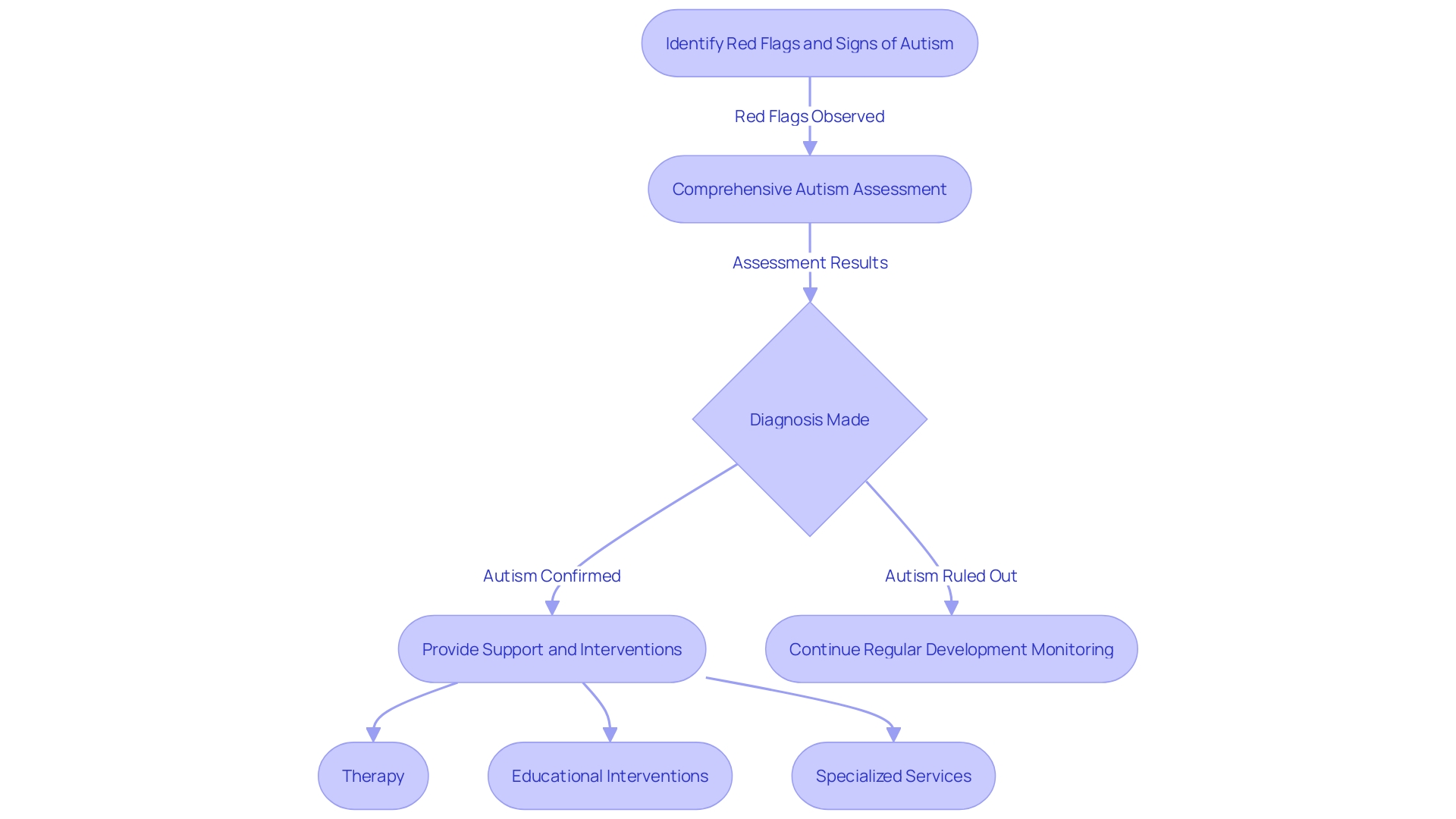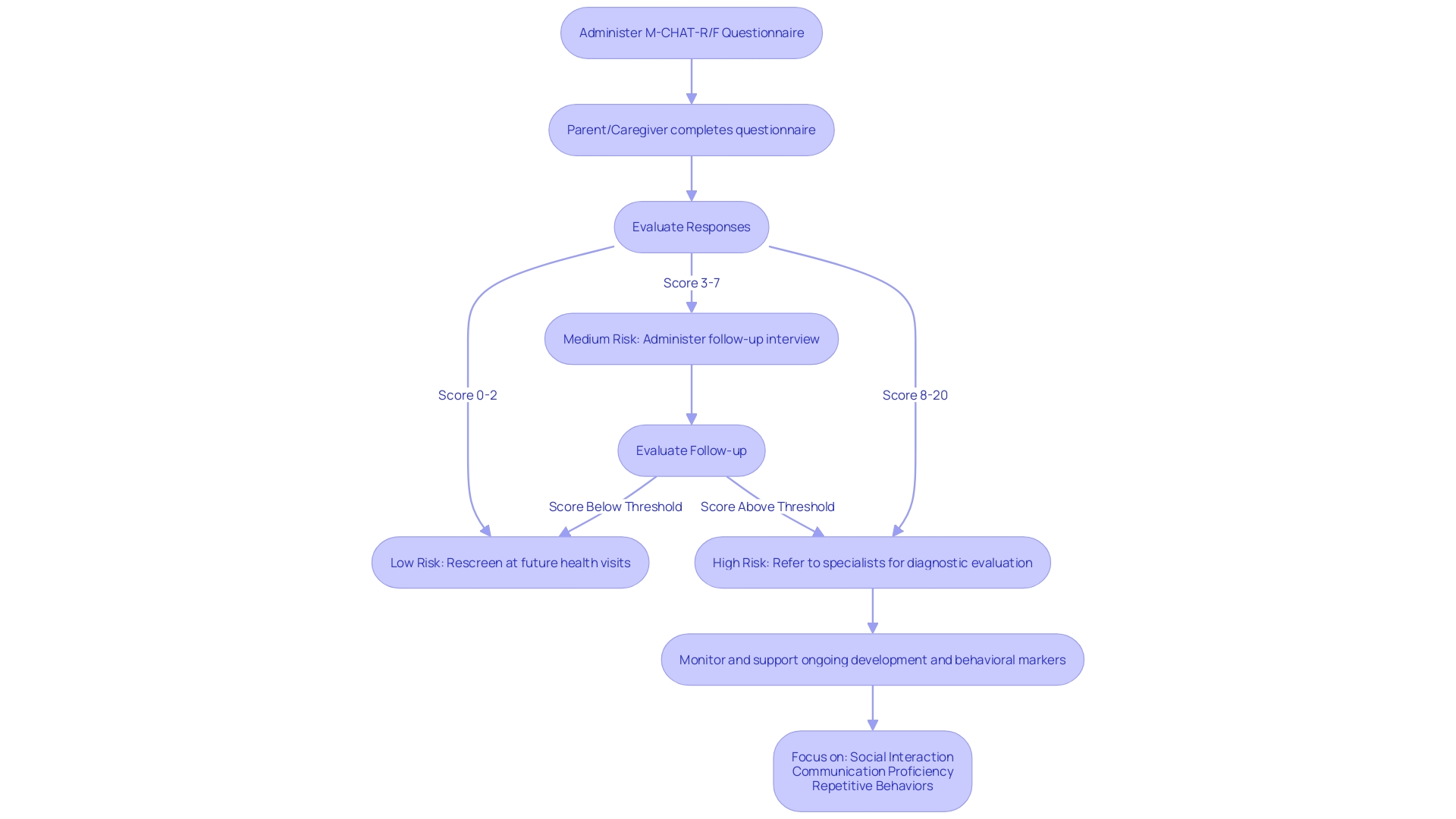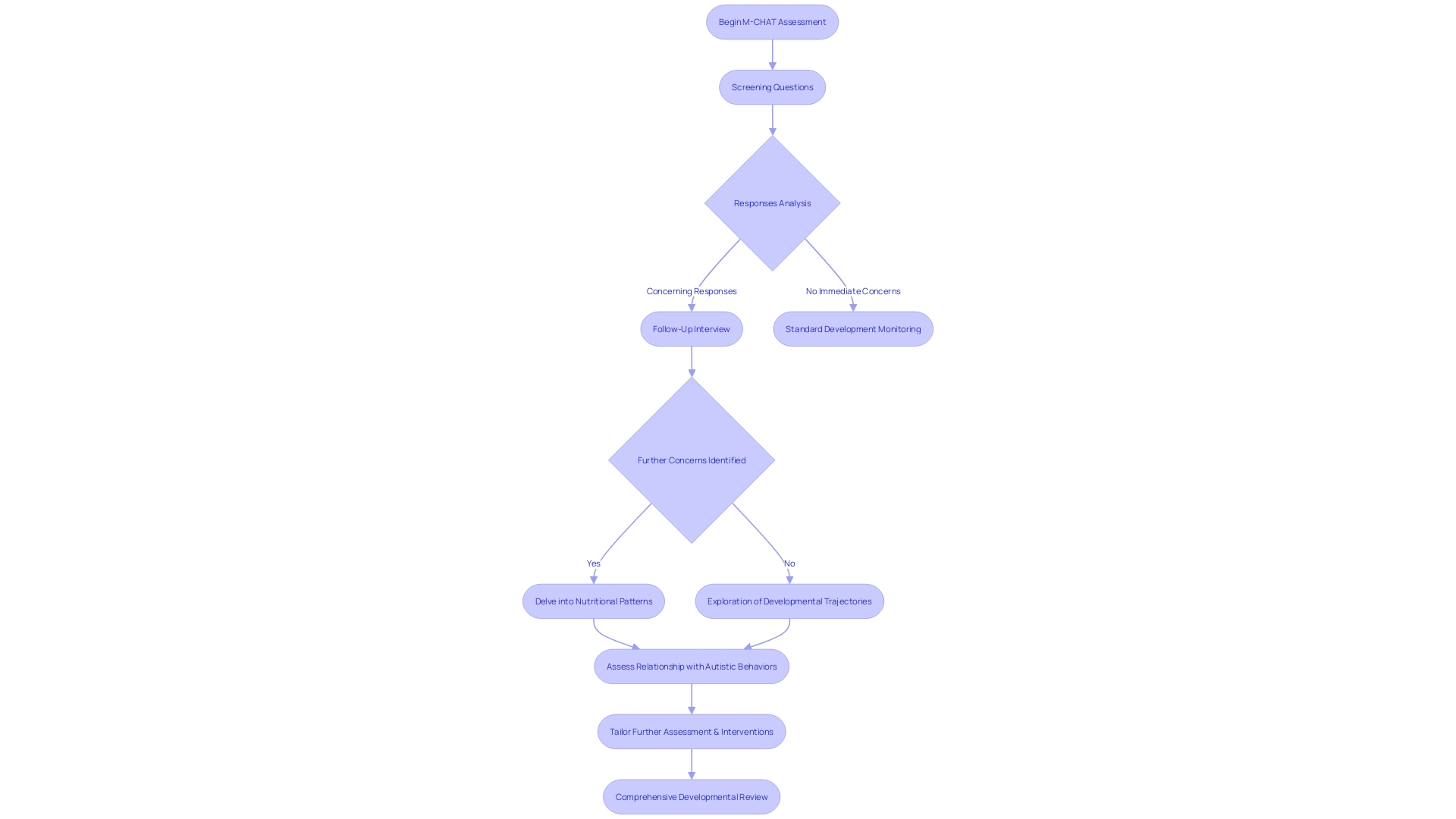Introduction
The journey to identifying Autism Spectrum Disorder (ASD) commonly includes the Modified Checklist for Autism in Toddlers (M-CHAT), a tool instrumental in paving the way for early intervention. This article will explore the importance of early autism screening, how the M-CHAT works, the role of healthcare professionals in M-CHAT administration, interpreting M-CHAT results, the significance of follow-up questions, advantages and limitations of the M-CHAT, and tips for parents considering the M-CHAT. By understanding these topics, parents and caregivers can navigate the screening process with confidence and ensure the well-being of their children.
Understanding the M-CHAT-R/F
The journey to identifying Autism Spectrum Disorder (ASD) commonly includes the Modified Checklist for Autism in Toddlers (M-CHAT), a tool instrumental in paving the way for early intervention. This tool takes the form of a straightforward questionnaire comprising 20 questions, all answerable with a simple 'yes' or 'no.'
These queries are meticulously designed to unravel subtle indications of ASD by examining a child's interactions and development. Pediatricians often use the M-CHAT-R/F during 16 to 30-month check-ups as a primary step in ASD screening.
While formal diagnosis can feel daunting, the ASD community acknowledges the value of self-identification. An official diagnosis may not be pivotal for everyone, and the journey through the testing process can be laden with ambiguity. It's a personal choice, as an adult in the neurodivergent spectrum may find peace and empowerment in understanding their identity with or without a medical label.
Importance of Early Autism Screening
Early autism screening is vital for identifying children who may be at risk for autism spectrum disorders. Research has shown that early intervention can significantly improve outcomes for children with autism. By identifying red flags and signs of autism early on, parents and healthcare professionals can ensure that children receive appropriate support and interventions as soon as possible.

How the M-CHAT Works
Grasping the nuances of the Modified Checklist for Autism in Toddlers, Revised with Follow-Up (M-CHAT-R/F) is a pivotal step for parents and professionals in the early identification of Autism Spectrum Disorder (ASD). This tool probes for signs indicative of ASD and places an emphasis on pivotal developmental and behavioral markers such as social interaction nuances, communication proficiency, and potential repetitive conducts.
Comprising pointed queries regarding observable behaviors, it provides a clear framework for evaluating responses. The scoring system furthers the process by directing whether a child should be referred for a more in-depth evaluation.
This kind of assessment resonates with the sentiment that an official diagnosis is not always necessary to identify as autistic, something the neurodivergent community acknowledges openly, citing the limitations of medical evaluations. Indeed, a profound analysis of autism treatment studies revealed a staggering variety of metrics used, except in adaptive functioning, hinting at the intricate landscape of autism assessment tools like the M-CHAT-R/F. These tools must be aligned with everyday functionality questions, bridging the gap between theoretical assessment and pragmatic living skills.

The Role of Healthcare Professionals in M-CHAT Administration
Screening for developmental milestones through autism testing is pivotal, and healthcare professionals are instrumental in this process. With the expertise to administer essential tools like the M-CHAT—a questionnaire designed to identify signs of autism spectrum disorder (ASD)—pediatricians and health providers become valuable allies to parents.
These professionals draw on their extensive training to carefully observe children's behaviors against normative milestones, providing personalized insights that guide further evaluation. When interpreting M-CHAT results, their role extends beyond mere administration.
They engage in meaningful dialogue with parents, offering clarity around complex developmental concepts, responding thoughtfully to concerns, and facilitating a supportive experience throughout the screening journey. By leveraging their nuanced understanding of both the Fact Sheet as an educational medium and the intricacies of ASD, these advocates in white coats bridge the gap between data and real-world application, ensuring that vital information is communicated effectively and accessibly—much like the successful healthcare organizations utilizing fact sheets for streamlined dissemination of knowledge. In doing so, they affirm their commitment to the health literacy of families they serve and reinforce the impact of professional case management in the healthcare system.
Interpreting M-CHAT Results
Understanding the nuances of the M-Chat's outcomes is pivotal for interpreting its significance in the context of a child's unique developmental trajectory. Meticulously crafted scoring rubrics guide the interpretation process, and a high score is a preliminary beacon, suggesting further specialist evaluations are warranted. It is here where the collaborative input of healthcare professionals becomes indispensable for an exhaustive analysis, potentially unraveling the presence of autism or other developmental anomalies.
Recent evolutions in research methodologies underscore the imperative of grounding clinical decisions in the bedrock of fresh insights from robust randomized-controlled trials, which have superseded quasi-experimental studies in the realm of autism – ensuring interventions are not only soundly evidenced but also tailored to the individual's nuanced needs. Additionally, community voices within the autistic spectrum highlight that a formal diagnosis, although valuable for some, is not a universal requisite for identifying with the neurodivergent community or accessing requisite support. This inclusive perspective acknowledges the multiplicity of experiences and reiterates the significance of personalized pathways in the journey of neurodiversity.
The Significance of Follow-up Questions
During the Modified Checklist for Autism in Toddlers (M-CHAT) assessment, follow-up questions are crucial to uncovering a fuller picture of a child's unique behaviors and development trajectories. By delving deeper with these supplementary questions, healthcare providers can identify nuanced aspects of a child's interaction with their environment—particularly in areas that may not be immediately apparent from initial screening responses.
For example, understanding a child's nutritional patterns can be telling, as eating habits are often intertwined with autistic behaviors. Insights gained from follow-up questions can illuminate specific challenges, such as those detailed in a provided brainstorm list of dietary and lifestyle factors. This comprehensive approach ensures that each child's developmental nuances are explored thoroughly, beyond the potential limitations of a standard medical diagnosis of autism.

Advantages and Limitations of the M-CHAT
Diving into the world of autism assessment, it's key to understand the tools available for early detection, such as the Modified Checklist for Autism in Toddlers (M-CHAT). This instrument is embraced for its practical benefits; it's not only cost-effective but also straightforward for both parents and practitioners to use.
However, the M-CHAT serves as an initial step, screening for potential indicators of autism rather than diagnosing the condition. Hence, while a positive M-CHAT result may raise a flag for concern, it is by no means the final word.
It signals a prompt for further, more comprehensive evaluations, emphasizing that a journey toward understanding a child's neurodiversity may not solely hinge upon test outcomes. In the words of an individual who navigated this journey, "If having an official autism diagnosis does not make a difference to you and the support you need to succeed, there’s no reason to spend the time, energy, and money to go through the process." This perspective echoes the broader autistic community's acceptance of self-identification and recognition of the imperfections within the medical testing model for autism.
Tips for Parents Considering the M-CHAT
As parents navigate the complexities of autism screening for their child, the M-CHAT (Modified Checklist for Autism in Toddlers) serves as a valuable tool. Understanding the M-CHAT is crucial, as it involves observing the child's behavior and relating it to the questions provided.
Parents can take proactive steps by observing their child in various situations and making a note of any behavior that seems unusual or aligns with the patterns the M-CHAT aims to identify. Furthermore, establishing an open dialogue with healthcare providers can significantly enhance the screening process.
Parents are encouraged to discuss their observations and concerns, ensuring a comprehensive understanding of their child’s development. While a formal diagnosis is not the only pathway to identifying as autistic, and the community welcomes self-identification, some parents seek official evaluation for specific personal reasons or to access certain support systems. It's vital for parents to recognize that seeking an M-CHAT evaluation is a personal choice and not a necessity for identifying as autistic or understanding one's neurodivergence.
Conclusion
In conclusion, the Modified Checklist for Autism in Toddlers (M-CHAT) is a valuable tool in the early identification of Autism Spectrum Disorder (ASD). Early autism screening is crucial for ensuring that children receive appropriate support and interventions as soon as possible.
The M-CHAT-R/F is designed to probe for signs of ASD, focusing on developmental and behavioral markers. Healthcare professionals play a vital role in administering the M-CHAT, offering guidance and support to parents throughout the screening process.
Interpreting M-CHAT results requires collaboration with professionals to analyze the significance in the context of a child's unique developmental trajectory. Follow-up questions are essential in uncovering nuanced aspects of a child's behavior and development.
The advantages of the M-CHAT lie in its cost-effectiveness and simplicity, but it should be understood as an initial screening tool rather than a diagnostic tool. A positive result on the M-CHAT signals the need for further comprehensive evaluations. It's important for parents to recognize that seeking an M-CHAT evaluation is a personal choice and not a requirement for identifying as autistic or understanding one's neurodivergence. By understanding these key points and engaging in open dialogue with healthcare professionals, parents can navigate the screening process with confidence and ensure the well-being of their children. The journey to identifying ASD may not always require an official diagnosis, as self-identification and recognition of neurodivergence are valid and empowering.




